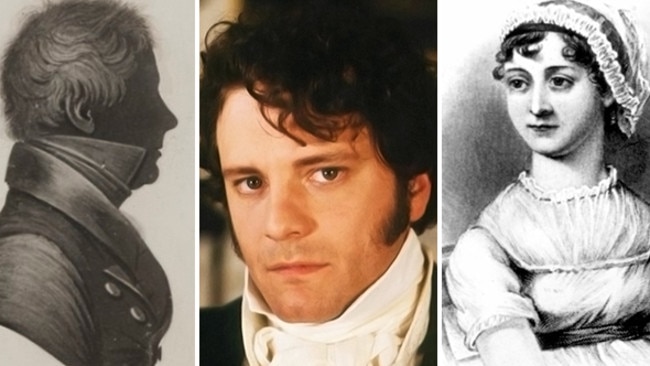Jane Austen & D’Arcy Wentworth: did a Sydney surgeon steal her heart?
Author Wal Walker makes the groundbreaking claim that a colonial surgeon stole Jane Austen’s heart.

Did Jane Austen (1775-1817) have an Australian connection? In Jane & D’Arcy, Australian author Wal Walker makes the groundbreaking claim that colonial surgeon D’Arcy Wentworth (1762-1827) was the love of her life.
Austen readers have long detected the complex emotional experience revealed in her writing is at odds with the portrait created by relatives of an unworldly, withdrawn, utterly respectable spinster aunt.
Their protestations that there was nothing to tell have always prompted the question: What are you hiding? But the identity of who she did love, and whether it was one man or just flirtations, as the family claimed, has never been satisfactorily established.
By juxtaposing extensive research into Wentworth’s life with the emotions, characters and events in Austen’s writing, Walker makes a very creditable case for the Irish-born Sydney colonial doctor as the object of her passionate love.
‘‘She was intimately acquainted too with his Family who were her relation,’’ Austen wrote in her unfinished early novel Kitty, or the Bower. Indeed she and Wentworth were related. Both were descended from Thomas Wentworth, 1st earl of Strafford: he through a male line in Ireland, she through her mother, who was Strafford’s granddaughter.
Austen’s History of England recounted the tragic story of Strafford, heir to the great estate of Wentworth Woodhouse. She was proud her family was recognised by the Wentworths as a connection, and D’Arcy felt the same. The young surgeon was close to the head of the family, Earl Fitzwilliam Wentworth, who played an important role in his life in England as well as in Australia.
Allusions to the Wentworths permeate Austen’s work, beyond the choice of Darcy and Wentworth as names. Lord Fitzwilliam’s name is combined with the character of his brother George: ‘‘in person and address most truly the gentleman … there was a softness in Colonel Fitzwilliam’s manners”. Other family associations include names such as Watson, Woodhouse, Ferrers, Bertram and Musgrave, whose context has been unknown until now. A further link is D’Arcy’s friend William Wickham, a young lawyer whose home was near a village named Bingley.
Walker believes “Jane had a great desire to hear and to say D’Arcy’s name aloud. By making Darcy a surname, she gave her characters the freedom to speak it without reserve. By this means she ensured his name and her great love for him have resounded across the years.’’
He demonstrates how the timing of the romance fits with Austen’s recorded movements and with the highs and lows of Wentworth’s situation before he self-transported to Botany Bay after one too many acquittals for highway robbery.
Their relationship peaked over two years when Wentworth was hanging around in England, waiting for confirmation of his appointment as a ship’s surgeon. He was completing his medical training by ‘‘walking the wards’’ (unpaid) of a London hospital and running out of money to the extent that in 1788 he worked for an apothecary in Alton near Austen’s home.
Through a close reading of Austen and a deep knowledge of Wentworth’s life, Walker demonstrates where and when they might have met, and what brought them together. Austen’s writing reveals knowledge of significant aspects of his life. She understood the attraction of London coffeehouses, for example. ‘‘They met for the sake of eating, drinking and laughing together, playing at cards’’ (Sense and Sensibility). She recognised how cards expanded to gambling as a means of funding Wentworth’s medical studies. ‘‘I know little of the game at present, said he, but I shall be glad to improve myself, for my situation in life’’ (Pride and Prejudice). And she knew it was not losses but his winnings that led to his career as a highwayman. His creditors ‘‘blushed at the idea of paying their debts’’ (Love and Friendship).
She also knew something about surgeons. In The Watsons a young doctor is busy because ‘‘just now it is a very sickly time in Guildford’’. Writing to her sister Cassandra, she noted “a Country Surgeon would not be introduced to Men of rank’’.
After Wentworth left England in 1790, he was not someone Austen might see next week, or next month. He was far away. In Northanger Abbey, ‘‘The torments of absence were softened by a clandestine correspondence.’’ The importance of a letter, yearning for a letter, is a recurring theme in her books. When an emissary delivered one ‘‘she began not to understand a word’’ he said (Persuasion). ‘‘It was the only thing approaching a letter she had ever received from him; she might never receive another … to her the handwriting itself, independent of anything it might convey, is a blessedness (Mansfield Park). ‘‘The letter, when she was calm enough to read it, brought little comfort’’ (Sense and Sensibility). ‘‘Such a letter was not to be soon recovered from’’ (Persuasion).
Why has Wentworth never before been considered as a candidate? Well, it took an Australian to pay attention. To an Australian, D’Arcy Wentworth is a significant historical figure, not someone to be brushed aside with a passing nod to his notoriety as a highwayman. Indeed, Walker’s insightful portrait of the elder ‘‘Australian’’ Wentworth is an achievement in its own right. Jane & Darcy deliversfresh information about Wentworth’s circumstances, his dedication to medicine and his precarious early years.
Walker found no explicit document to prove Wentworth was Austen’s ‘‘missing’’ love. He has however marshalled impressive circumstantial evidence to demonstrate that he could have been: the opportunities for them to meet, the family connection to create a special bond, the availability of long-distance emissaries between the two, such as Captain Hunter and others from Australia. His research revealed a crucial gap of three years in Austen’s letters. And it highlights the comment made by Austen’s niece 68 years later when she wrote of ‘‘some peculiar comings and goings coinciding exactly with what my Mother more than once told me of that affair’’.
Jane & D’Arcy is a hugely enjoyable piece of historical detection that imaginatively re-creates the romance. Walker, who is a descendant of Wentworth, never forgets Austen’s status as a literary figure and he takes care to avoid the undue sentimentality that can occur in ancestral biography.
He has a second volume, Jane & D’Arcy: Such Talent & Such Success, due soon, according to his website janeanddarcy.com.
Whether Jane and D’Arcy consummated their love with marriage is another matter. On this, I think Walker overstretches his argument. Nevertheless, no future Austen reader will be able to ignore the likelihood their relationship is ‘‘the key to understanding the recurring themes and connections in her stories, her sensitivities and her pride’’.
Babette Smith specialises in colonial history. Her latest book is The Luck of the Irish.
Jane & D’Arcy: Jane Austen & D’Arcy Wentworth, Volume 1: Folly is Not Always Folly
By Wal Walker
Arcana Trust, 430pp, $36.95


